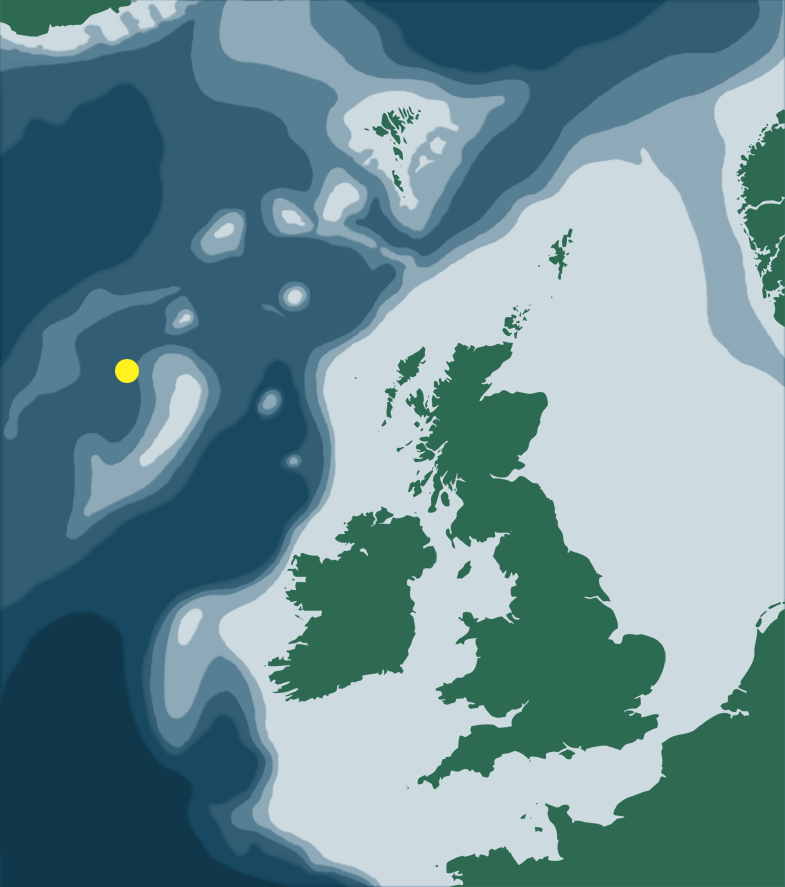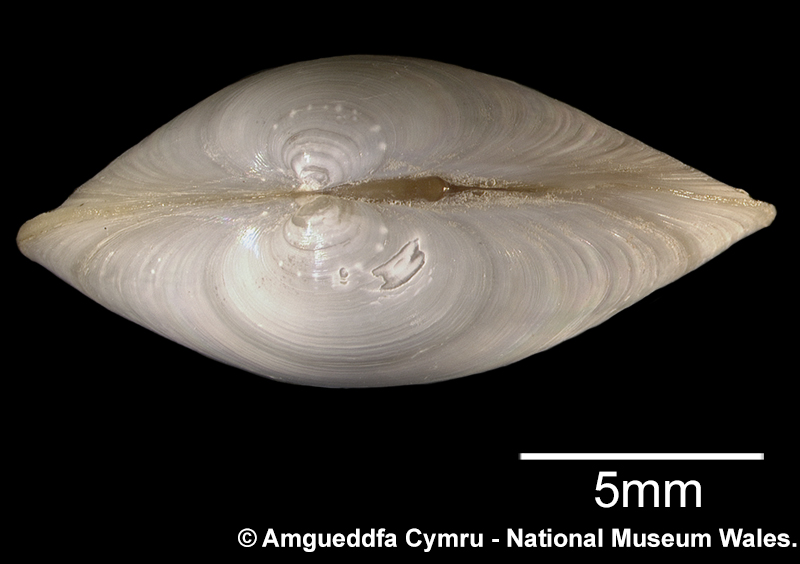Isorropodon mackayi Oliver & Drewery, 2014
Glossoidea : Vesicomyidae |
| Tebble name: | n/a |
| Smith & Heppell name: | n/a |
To size: To 16mm. Shell Structure: Brittle, rather thin. Equivalve: Equivalve. Equilateral: Inequilateral, beaks well in front of midline. Tumidity: Rather slender. Outline: Elliptical, distinctly longer than high, umbos low, dorsal margins gently sloping, anterior bluntly rounded, posterior more narrowly rounded, ventral gently curved. Lunule narrowly cordate defined by a weak incised line. Escutcheon very shallow and narrow.
Sculpture: Shiny, smooth except for weak commarginal lines and undulations. Margin: Inner margin smooth. Ligament: External, slender, set on a shallow nymph. Hinge: Three small teeth in each valve, RV with a prominent spoon shaped 1 projecting ventrally, 3a and 3b joined, parallel with hinge margin, 3a ~-shaped, 3b simple; LV with a simple 4b at an angle to the hinge plate, 2a and 2b joined, parallel with hinge margin, 2a ~-shaped, 2b simple. Pallial Musculature: Scars weakly impressed, indistinct. Adductor scars subequal.Pallial sinus as a weak straightening only, not indented. Periostracum: Very thin, transparent. Colour: Shell off white.
Distribution & Ecology
Depth Range
Bathyal (500 - 2000m)

Additional Information & Related Species
Juvenile Description
Key Features & Similar Species
Other species are reported from the Mediterranean and more southern parts of the Atlantic Ocean, see papers below.
Related Species
Glossoidea : Vesicomyidae
References
Listed are literature citing Isorropodon mackayi Oliver & Drewery, 2014. Reference containing the species Type Description is highlighted.
|
Cosel R. & Salas C. 2001. Vesicomyidae (Mollusca: Bivalvia) of the genera Vesicomya, Waisiuconcha, Isorropodon and Callogonia in the eastern Atlantic and Mediterranean. . Sarsia. 86: 333-366. |
|
Krylova, E.M., Gebruk A.V., Portnova D.A., Todt C. & Haflidason H. 2011. New species of the genus Isorropodon (Bivalvia: Vesicomyidae: Pliocardiinae) from cold methane seeps at Nyegga (Norwegian Sea, Vøring Plateau, Storrega Slide). . Journal of the Marine Biological Association of the United Kingdom. 91: 1135-1144. |
|
Oliver P.G. & Drewery J. 2014. New species of chemisymbiotic clams (Bivalvia: Vesicomyidae and Thyasiridae) from a putative ‘seep’ in the Hatton-Rockall Basin, north-east Atlantic.. Journal of the Marine Biological Association of the United Kingdom. 94 (2): 389-403. |
|
Oliver P.G., Rodrigues C.F. & Cunha M.R. 2011. Chemosymbiotic bivalves from the mud volcanoes of the Gulf of Cadiz, NE Atlantic, with descriptions of new species of Solemyidae, Lucinidae and Vesicomyidae. Zookeys. 113: 1-38. |
Resources
- Conchological Society
of Great Britain & Ireland
Provides resources for understanding, identifying, recording, and conserving molluscs - CLEMAM
Check List of European Marine Mollusca - MarLIN
The Marine Life Information Network for Britain and Ireland (MarLIN) provides information for marine environmental management, protection and education. It is a centre of excellence in spatially based and time-series marine biological information and supports good stewardship in the marine environment. - NBN Gateway
National Biodiversity Network's Gateway. Use it to explore UK biodiversity data, as contributed by participating data providers. - BivAToL
- MarBEF
- Malacological Society
- Unitas Malacologica
- Census of Marine Life
- MarBEF
MarBEF, a network of excellence funded by the European Union and consisting of 94 European marine institutes, is a platform to integrate and disseminate knowledge and expertise on marine biodiversity, with links to researchers, industry, stakeholders and the general public.











